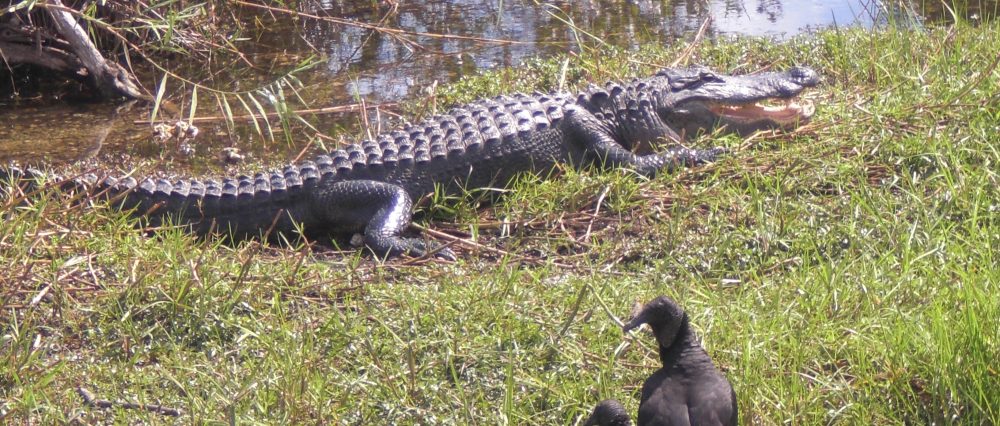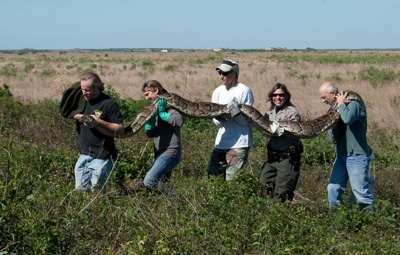A shy intruder takes up residence in South Florida
By Quenton Narcisse
Throughout south Florida, the arrival of Burmese pythons has caused quite a stir and now there may be upwards of 150,000. Yet finding them is not easy.
“Contrary to popular belief, there aren’t a lot of pythons spotted in Big Cypress,” said Bob DeGross, chief of interpretation at the Big Cypress National Preserve located east of Naples, Fla., “Officials have totaled the number of pythons between 5,000 and 150,000, which is another way of them saying they have no idea how many pythons there are down here. But like everyone else, we’re well aware of what they’re capable of.”
Since they were first spotted more than a decade ago these snakes have been the topic of discussion by national media and scientists alike. A recent study blamed the pythons for the likely demise of 90 percent of the Everglades small mammals. News stories have included one in October 2005, when wildlife researchers found a dead, headless python in Shark Valley after trying to digest a six-foot alligator. Last year, a python was found resting after swallowing a 75-pound deer in its entirety.
Despite all these findings, researchers are still trying to understand how the python is affecting the environment.
“We don’t have a very good understanding yet of what the impacts of the pythons are in the park just yet,” says Larry Perez, a science communications interpreter at Everglades National Park. “But one of the interesting things about their presence here is that we’ve learned more about the Burmese pythons from studying them in South Florida than we have ever learned about the life species in their old range.”
Perez, who acknowledged the pythons’ ability to reproduce at a large rate, stated that each one they find is taken into a laboratory and euthanized. Half of them are cut open and examined, which helps scientists learn more about the species literally “from the inside out”.
Added Perez: “One of the quantitative things we’ve been able to document, of course, is what they’ve been eating. We find that by species, a little less than 75 percent [of what pythons eat] are small to medium sized animals. The less-than 25 percent are wading birds – particularly birds that hang around the water’s edge.”
Where did these snakes come from in the first place? DeGross believed it was the cause of pet trade, pointing to the transactions between Asia and the United States.
“Once the pythons got here, it came down to two things: pet owners releasing them out into the environment and Hurricane Andrew,” he says. “These two acts primarily factored into what you see now.”
DeGross stated that Florida is taking the necessary steps to prevent owners from dumping snakes into the Everglades, pointing to federal laws and recent administrative orders. It is illegal to import snakes , and one cannot own an invasive species unless it has a microchip attached to it and the owner pays a $100 annual fee
Lisa Jameson, an invasive species biologist with the Arthur R. Marshall Loxahatsee National Wildlife Refuge, said there are multiple outreach programs available for owners looking to get rid of their snake as well as other invasive species.
“Educate yourself on what’s in your area, and what it can do,” Jameson says. “Prevention is the way to go. And rapid response. And outreach and education. Even back then, we weren’t educating ourselves, so we just have to be more aware.”
In dealing with python, officials are also concerned about what they could possibly do to people.
“From 1980 to 2010, there have been 14 attacks on humans; all from pythons who were captive,” says Perez. “There have been 30 attacks on dogs, but a snake attacking a person unprovoked is pretty unfamiliar.”
Unlike rattlesnakes, pythons are non-venomous species, which means they rely on suffocation as a way to kill their prey. Most of the attacks on people occurred when the person reached out at the snake, triggering its protective nature. Jameson states that it’s a common occurrence with people who are excited to see and get around pythons.
“The most frequent place a person is bit is in his or her hand, because their first instinct is to reach out and touch the snake,” says Jameson. “But like most animals in the wild, if you corner it or go after it’s young, it’s probably gonna go after you. They get real aggressive.”
Which is why it’s vital that people get familiar with the tendencies of these species.
“There’s absolutely no control method that we have against Burmese pythons,” says Perez. “They’re gonna be here for an awfully long time.”

